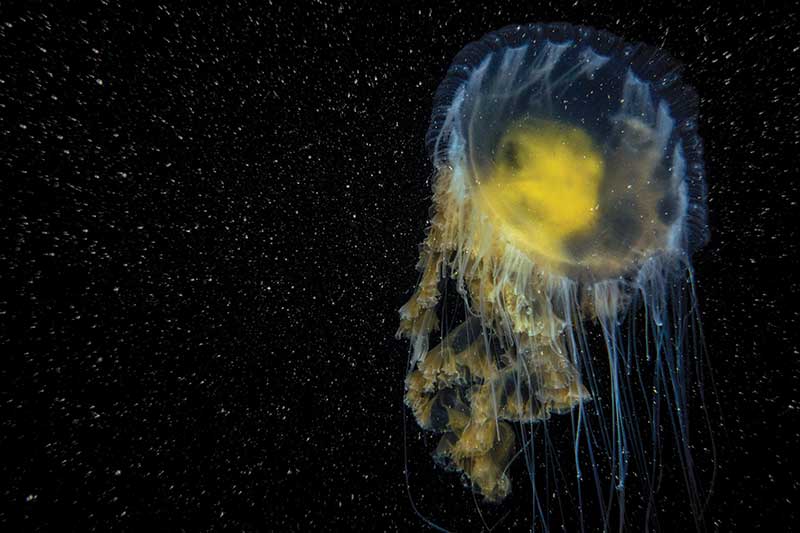Divers and jelly stings
By Divers Alert Network

Jellyfish are often associated with tropical climates—their gelatinous bodies are commonly seen drifting through warm waters—and they’re known for stinging unsuspecting divers, swimmers, and beachcombers. Cold water divers might be forgiven, then, for thinking that jellyfish stings are a problem they don’t really have to worry about, but that’s not quite true: certain species of jellyfish are found in cold water, and some of them can be hazardous to divers. Although stings are rare (and wearing a drysuit or lots of neoprene provides significant protection), cold water divers should not be complacent.
There are four classes of jellyfish worldwide; two of which are found in northern American and Canadian waters: Scyphozoa and Hydrozoa. Scyphozoa jellyfish include lion’s mane, moon jellies and fried egg jellies. These are considered ‘true jellyfish’. The crystal jelly, or Aequorea, is a hydrozoan.
If you’re stung
Jellyfish stings can be incredibly painful, but the severity of the injury is determined by species, size, geographic location, and time of year, among other natural factors. The fried egg jelly, for example, has a mild sting, while the sting of the lion’s mane jellyfish can cause a severe allergic reaction.
If you are stung by a jellyfish, remain calm, get out of the water, and start performing first aid. First the wound needs to be cleaned using vinegar. Apply it for at least 30 minutes or until the pain beings to diminish. If vinegar is not available, rinse the skin with sea water, but do not rinse with fresh water. While use of seawater can help reduce pain, rinsing with fresh water can make the pain worse.
After rinsing, check the affected area to see if there are any remaining tentacles. Using tweezers, pluck them away. Avoid scraping off the tentacles, as scraping on the skin could cause the release of more venom and/or spread stinging cells around on the skin. Once tentacles are removed, decontaminate and/or rinse the area once again. It is common for the affected skin area to become red or bumpy. Whiplike marks on the skin may also appear. To reduce pain and help the healing process, consider soaking the area in hot—but not uncomfortably hot—water (45°C or 115° F) for about 45 minutes.
One in the eye
If a jellyfish stings you in the eye, either immerse the affected eye in a container of salt water or pour a gentle steam of salt water from a clean jug over the eye. Once the eye has been flushed, an emergency ocular exam may be necessary. A sting directly to the eye could cause severe pain, tearing, redness, swelling of the eyelids, or potential injury to the cornea.
In the event the injured person has trouble breathing or swallowing, becomes dizzy, is nauseated, contracts muscle spasms, or if the pain is intense, contact emergency services immediately.
Jellyfish are best observed from afar, but that’s not always possible given their long tentacles! Often free-floating tentacles can become wrapped around a regulator’s mouthpiece, and are practically invisible to divers and swimmers.
While in the water or walking beaches, stay aware of your surroundings to prevent unwanted stings. Remember also that not all jellies sting. Getting to know your local fauna will not only help keep you away from unwanted stings, but also make your dives richer experiences!
For more safety information on safe diving practices visit: www.dan.org
Leave a Comment







